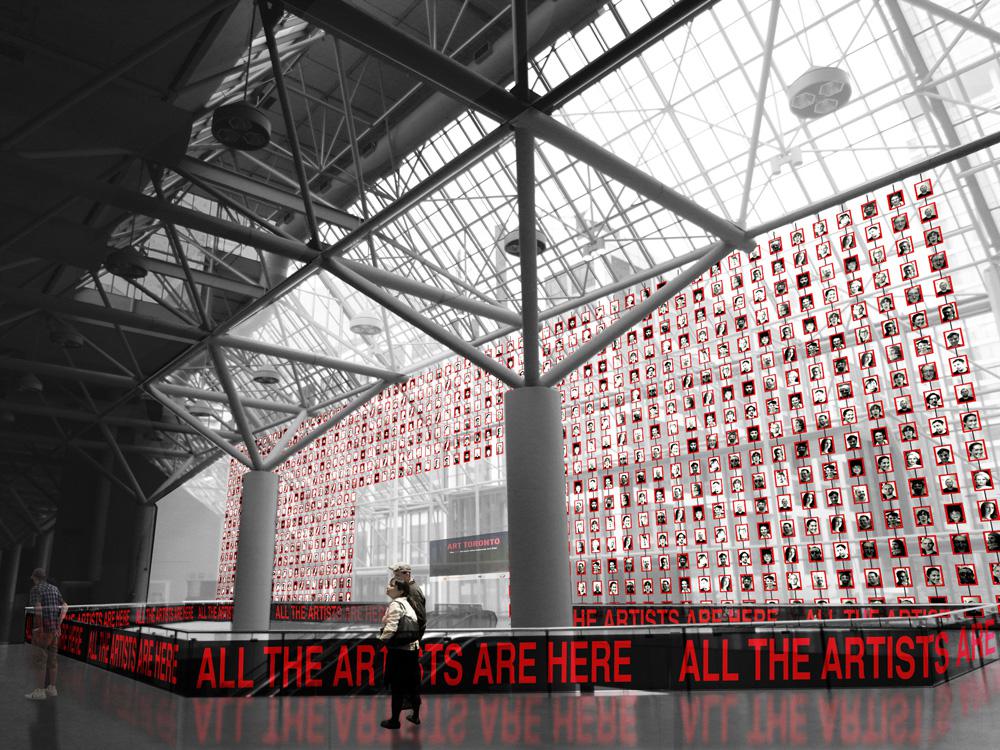Toronto’s Thom Sokoloski—known for large-scale art installations as well as theatre and opera productions—generally enjoys art fairs. But he has one problem with them.
“I think we should celebrate all the artists,” he says. “Whenever I go to an art fair, I see their work and I see their galleries and I see their gallery’s people. But I never see the artists.”
Sokoloski’s Art Toronto solution is All The Artists Are Here, a massive portraits installation above the entrance that shows some 1,000 artists represented at the fair. It will be an unmissable gesture at the gala opening tonight and through the fair’s run to October 28.
Yet there are living, breathing artists at Art Toronto—and an increasing number are representing themselves, in fact.
The five Toronto artists in Blunt Collective (Booth 1315) have successfully represented themselves at Aqua Miami, Scope New York, Next Chicago and other fairs. (After Art Toronto, they’re headed to Context Art Miami.) Through collaborative agreements, they’ve brought the work of more than a dozen other artists to fairs as well.
“Everyone’s trying to figure out where art fairs fit with different models of exhibiting,” says Blunt member Natalie Majaba Waldburger. “We’re trying to find a way of using that venue creatively.”
Blunt formed in post-crash 2009, when many local dealers were not taking on emerging artists. Others were, but weren’t at fairs.
Since then, Blunt’s fair activities have led to gallery exhibitions for some members. And it’s also fostered an appreciation of what galleries do year-round.
“The workload a gallery does is phenomenal,” Blunt’s Matthew Schofield says. “I respect that more now than when we started.”
Blunt credits Toronto’s artist-collective legacy—from the Group of Seven in the 1920s to Painting Disorders in the 1990s to AWOL Gallery today—as an influence.
“It’s kind of in our DNA,” Waldburger says. She also notes dealer (and fellow OCAD graduate) Katharine Mulherin (Booth 1106) helped plant the collective idea for them early on. The group doesn’t see collective representation and commercial representation as being mutually exclusive, but rather aspects that could complement each other.
Red Head (Booth 944) is a 23-year-old artist-led group that maintains a permanent Toronto gallery. Having done Art Toronto in 2011, it’s returning to make connections.
“At the fair, there’s a camaraderie and an openness, and people take time for conversations” that they might not otherwise, Red Head member Lynn Kelly says. “We get to talk to galleries around the world and connect more with the local scene too.”
Other organizations, like printmaking-focused artist-run centre Open Studio (Booth 100) promote not only their artists, but their medium.
“We want to raise the profile of printmaking,” says Open Studio executive director Jennifer Bhogal. She thinks collectors know less about it since the advent of high-end reproductions a decade ago.
“In the 60s and 70s, with Warhol and Lichtenstein, there was more understanding” of the print medium, Bhogal says. The Open Studio team hopes to revitalize that knowledge in discussions at the fair.
Art Toronto is also an important part of boosting Open Studio’s year-round print-sales operation—an effort that has also involved exhibiting at the Interior Design Show in recent years.
“Many nonprofits are realizing that the ones that can continue to do really well have worked at diversifying how they bring revenue in,” Bhogal says. Even though the gallery is successful at obtaining grants, there’s still a lot of the budget that public funds can’t cover, and print sales at fairs help bridge the gap.
Dopamine Collective (Booth 1317) is very new group whose seven members identify more as scientists than as artists. Their materials include x-ray films, dental molds and antiquated technologies.
“We’re a group of non-artists performing a series of experiments examining the art world from the outside,” Dopamine member Sean Stewart says. “But maybe after Art Toronto we won’t be in that position anymore. It’ll be interesting to see at what point we become artists.”
For daily updates on Art Toronto during the fair, visit canadianart.ca/arttoronto. Also join us at Booth 940 for talks, subscription specials and more.









